Climate Metrics and targets
Our rigorous approach to ensuring our business is strong and resilient to potential climate-related risks extends to how we manage our own climate impacts.
We are committed to building long-term climate resilience. Our ambitious targets are reflective of this commitment, and we strive every day to deliver greener solutions that will help us meet them. We are actively working toward reducing our greenhouse gas (GHG) emissions and are empowering our customers with solutions to help them reduce their own footprint.
We follow the GHG Protocol Corporate Standard to assess our GHG emissions, using CO2 equivalent (CO2e) which considers CO2, CH4 and NXO. We use the equity share approach, which means we account for emissions from each of our businesses based on our equity interest in the business.
Scope 1 and 2 GHG Emissions
OUR GHG REDUCTION TARGETS
Aligned with a 1.5 degree warming scenario and calculated based on the Science Based Targets initiative (SBTi) methodology
25%
reduction in scope 1 and 2 emissions by 2025
46%
reduction in scope 1 and 2 emissions by 2030 compared to 2019 baseline.
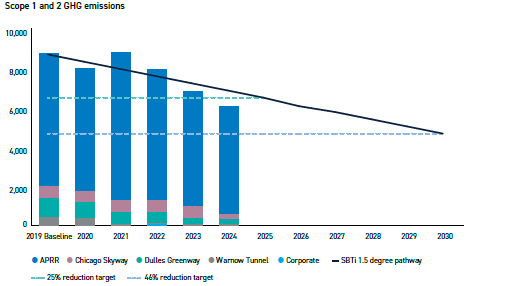
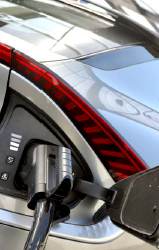
Electrifying the light vehicle fleet
- An additional 102 electric light vehicles in use, bringing total to 434 (approximately 41% of the light vehicle fleet, up from 31% coverage in 2023 and 13% coverage in 2022).
- An additional 19 own-use charging stations (each offering two charging points) introduced, taking the total to 209.
- APRR aims to convert 75% of its light vehicle fleet to electric vehicles by 2025.
Ongoing implementation of the 'Energy sobriety' plan
- Four pillars to realise energy savings: air conditioning/heating; lighting; travel; and use of equipment.
- Focus to date on hot-water distribution points in buildings and on heating/cooling systems in technical (server) rooms

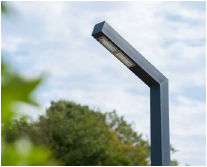
LED replacement program
- All rest areas now equipped with LED lighting.
- Program rolled out through toll plaza canopies and in buildings and progressing in other areas (eg tunnels).
Equipment Upgrades
- Replacement sites prioritised based on age of equipment.
- Ongoing replacement of energy intensive operating equipment.
- Includes replacement of energy-intensive gas boilers with more efficient models.
- An additional five boilers were replaced in 2024.
- Plans to change four oil boilers with wood or heat pumps in 2025.

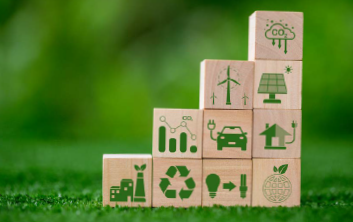
‘Acting low carbon’ training
- Training introduced in 2023 to build a low-carbon culture.
- At the end of 2024, 100% of employees had completed the training.
- Additional mandatory eco-driving training (to reduce fuel consumption) was completed by 31% of employees by the end of 2024.
Scope 3 GHG Emissions - Suppliers
We follow the Greenhouse Gas Protocol, which is the internationally recognised framework for calculating carbon emissions. It divides scope 3 emissions into upstream and downstream sources.
There are 15 different categories of scope 3 emissions: 8 upstream and 7 downstream. Upstream scope 3 emissions are generated by suppliers to enable our businesses to provide roadways, infrastructure and supporting services. Downstream scope 3 emissions are generated by our customers when using our roadways. Not all categories are material or relevant to all of our businesses. A materiality analysis was undertaken for each of our businesses to assess the impact of each upstream and downstream category. While we have been reporting on customer emissions since 2019, we are pleased to be able to report on our material upstream scope 3 emissions for the first time in 2024
Our baseline year for scope 3 emissions is 2019 (corresponding with our scope 1 and 2 emissions). We calculate the majority of our upstream scope 3 emissions using the ‘spend’ methodology, where emissions are estimated based on the amount spent in a particular category. Each item of expenditure is considered and categorised and an emission factor applied. This calculation has been undertaken for our baseline year of 2019 and for 2023 and 2024.
The data shows that Atlas Arteria is tracking well ahead of both of the SBTi potential scope 3 2030 pathways.1 The reduction reflects lower spending, especially on higher emission projects such as construction and maintenance, in 2023 and 2024 compared to 2019.
1. Note that customer emissions are not included in the SBTi pathways. The two SBTi pathways are Well Below 2 degrees (WB2), relating to a reduction equivalent to 2.5% of the 2019 baseline each year, or 1.5 degree, relating to a reduction equivalent to 4.2% of the 2019 baseline each year.
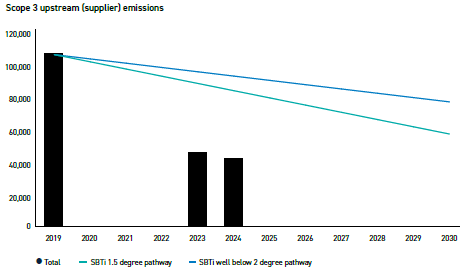
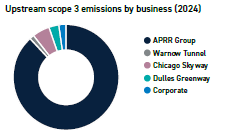
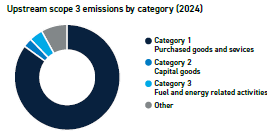
Scope 3 GHG Emissions - Customers
The overwhelming majority of Atlas Arteria’s total scope 1, 2 and 3 emissions are generated by our customers. Although we can’t directly control these emissions, we remain committed to empowering our customers to reduce their carbon footprint as they travel on our roadways. We do this by providing technology (such as electric vehicle charging stations) and infrastructure (such as free-flow tolling, carpool lanes and car parks, bike lanes and multi-modal hubs for better connectivity to public transport) to give customers greener travel options.
We calculate customer emissions based on an estimate of vehicle kilometres travelled on our roads and by applying emission factors. These emission factors are updated annually and reflect high-level changes in vehicle travel, including the take up of electric vehicles and any improvements in the fuel efficiency of internal combustion engines. The factors are not specific to our roads, so they do not necessarily reflect our businesses’ significant efforts to encourage low-carbon options. As the take up of lowcarbon vehicles increases, our factors will reflect this trend and we can anticipate lower emission estimates in the future
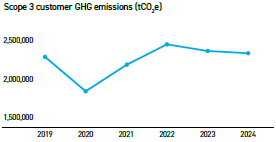
World-first initiative at APRR supports electrification of the transport sector
Heavy vehicles account for about 40% of transport-related CO2 emissions. That’s why APRR has partnered with ENGIE in a world-first initiative on a highway to install five (of the six total) charging stations for electric heavy vehicles and long-distance coaches along its network. The stations are located approximately 150 kilometres apart between Lyon and Paris and offer 400‑480 kW charging power per terminal. This initiative represents a significant step in the decarbonisation of the transport sector and is expected to prevent approximately 40,000 tonnes of CO2 emissions over 10 years.



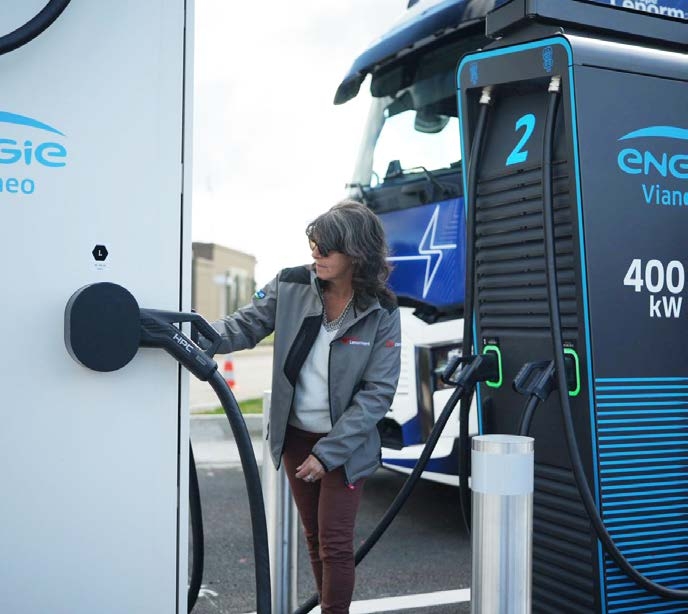
APRR offering access to greener ways to travel
APRR continues to empower its customers with multiple ways to reduce their carbon footprint. During the year, they added an additional 118 carpooling spaces across two new carpooling car parks. This brings the total number of carpooling spaces to more than 5,800, across 76 car parks. Carpooling offers customers an option to travel to one of APRR’s car parks, safely park their vehicles and travel in a carpool arrangement with others in dedicated carpool lanes.
They also commissioned a new multi-modal hub that features 100 carpooling spaces, a new pedestrian bicycle route that links directly to the car park and two bus stops. This two-way area makes it easier for people to use different forms of travel to reach their destination. So, when motorists leave the motorway, they can park their car for the day and opt for another means of transport (either shared or public) to get where they need to go in a faster and more environmentally friendly way.


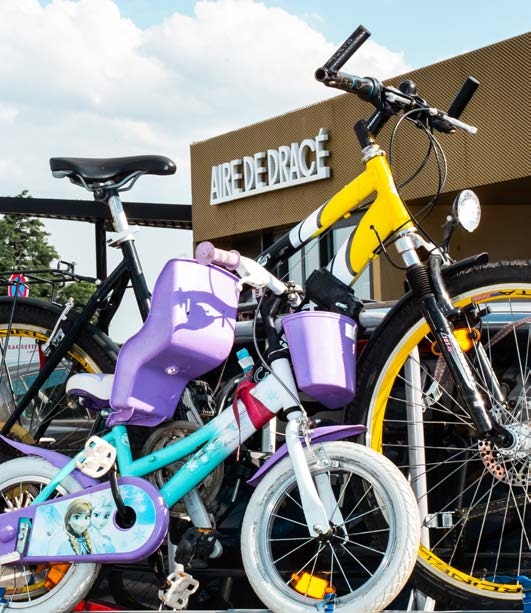
Supporting new low-carbon innovation
Atlas Arteria, through APRR, is continuing to support the testing and implementation of technologies to facilitate the transition to a low-carbon economy. As part of APRR’s Investment Plan, the majority of AREA's network entry points are being converted to free-flow tolling, which reduces emissions by removing the need for customers to stop and start at toll plazas. Other experimental projects were progressed in 2024, in particular the Alpine Hydrogen Highway project. The project aims to support the decarbonisation of heavy vehicle goods transport, thanks to green hydrogen. The hydrogen corridor runs between Lyon (France) and Turin (Italy). APRR formed a partnership with SFTRF, Hympulsion and HGV manufacturers in 2023 to support the project. The project is aiming to deploy at least 30 hydrogen-powered trucks in the region.
The European Climate, Environment and Infrastructure Executive Agency (CINEA) opens new calls annually for projects under the CEF-Transport program on behalf of the European Commission. The projects support the European Commission’s vision of a future sustainable transport system, with smart and resilient solutions implemented to interconnect Europe with the aim of building and modernising European transport infrastructure. In 2024, APRR was successful in the CEF2 Call for Projects and therefore benefits from access to a grant to carry out the SCALE project. SCALE is a continuation of the two Cooperative Intelligent Transport Systems (C-ITS) projects: C-ROADS and InDiD. The SCALE project will be spread over three years. It will involve testing automated vehicles in new use cases, such as automation in tunnels, when approaching work zones, and the way vehicles process information relating to obstacles on the road.
